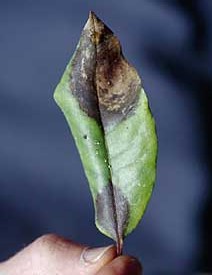Foliar pathogens
There are numerous fungi that cause foliar diseases on deciduous and conifer trees. Foliar pathogens can defoliate trees, thereby reducing photosynthetic capacity and cause an associated growth loss, or in some cases damage trees by causing branch and stem deformation.
Some circumstances where conifer foliar pathogens are usually damaging occur where trees are out of their native range (‘off-site’), occur in dense, pure stands, and when favourable weather patterns (cool/warm and moist) prevail during certain stages of the disease cycle.
Several of the foliar pathogens of conifers have been termed ‘needle casts’ or ‘needle blights’, depending on whether the disease symptom or a visible sign of the pathogen is emphasized.
- Needle cast refers to foliar diseases whose noticeable characteristic include premature needle drop (this is a disease symptom)
- Needle blight refers to diseases where killed needles remain attached with signs of the pathogen visible on the needle (this is a disease sign)
Needle cast or needle blight, complete or partial, can cause serious problems for conifers. The growth of trees is dependent on the photosynthetic activity of several years of needles. Any appreciable loss of needles is not followed by a complete replacement the following year as occurs with deciduous trees. Needle loss of any amount will have an impact on tree growth and conifer defoliation is typically fatal.
Common conifer foliar pathogens impacting commercial forests include:
- Didymascella thujina (Cedar leaf blight)
- Dothistroma septospora (Dothistroma needle blight)
- Elytroderma deformans (Elytroderma needle disease)
- Lophodermella concolor (Pine needle cast)
- Lophodermium spp. (Lophodermium needle cast)
- Meria laricis (Larch needle cast)
- Phaeocryptopus gaeumannii (Swiss needle cast)
- Rhabdocline pseudotsugae (Rhabdocline needle cast)
Foliar pathogens of deciduous trees are of relatively minor importance in cases where they cause partial defoliation. Complete defoliation is rare and only has great significance if it has occurred early in the growing season and over consecutive years. Although defoliation may not result in mortality it does result in reduced growth and reduced resistance to other stress factors.
Common foliar pathogens of deciduous trees include:
- Melampsora occidentalis (Cottonwood leaf rust)
- Septoria musiva (poplar leaf blight)
- Venturia macularis (Aspen and poplar shoot blight)

Foliar disease on a Rhododendron leaf
Learn more
Contact information
Contact us if you have further questions about managed-stand pests and how they are controlled in B.C.
